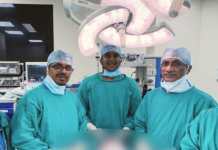Drinking Water supplied by MCC Contains fecal coliform – Palemar
Mangaluru: “The drinking water supplied to the people in the city by the MCC is not fit for consumption. The MCC should purify the water before supplying it”, said the former district minister in-charge Krishna J Palemar in a press meet held at the Press club here on January 5.
Addressing the mediapersons Palemar said, “Water samples collected from various places such as Suratkal, Krishnapura, Bondel, Chilimbi and Katipalla were sent to the laboratory for testing. During the sample testing at the Mangaluru Biotech Lab, it is found that the water is contaminated with fecal coliforms. MCC should take all the measures to purify the water before supplying it to the city for drinking”.
Palemar also said, “According to the lab report, the water which was collected from Suratkal government hospital was found contaminated with fecal coliforms of 1,600 counts per 100ml. In Katipalla the water which was collected from the Masjid was also found with fecal coliforms. It is a serious issue and the leakage in the sewage pipeline may be one of the reason for the water to be contaminated.
Fecal coliform bacteria
The total and fecal coliform bacteria test is a primary indicator of “potability”, suitability for consumption of drinking water. It measures the concentration of total coliform bacteria associated with the possible presence of disease-causing organisms.
Sources of Fecal Coliform
Coliform bacteria are a natural part of the microbiology of the intestinal tract of warm-blooded mammals, including man. Coliform bacteria can also be found in soil, other animals, insects, etc. The total coliform group is relatively easy to culture in the lab, and therefore, has been selected as the primary indicator bacteria for the presence of disease-causing organisms.
Potential Health Hazards
Coliform bacteria are not pathogenic (disease causing) organisms and are only mildly infectious. For this reason, these bacteria are relatively safe to work with in the laboratory. If large numbers of coliforms are found in water, there is a high probability that other pathogenic bacteria or organisms, such as Giardia and Cryptosporidium, may be present. The PADEP requires public drinking water supplies to demonstrate the absence of total coliform per 100 ml (about 4 oz) of drinking water.














